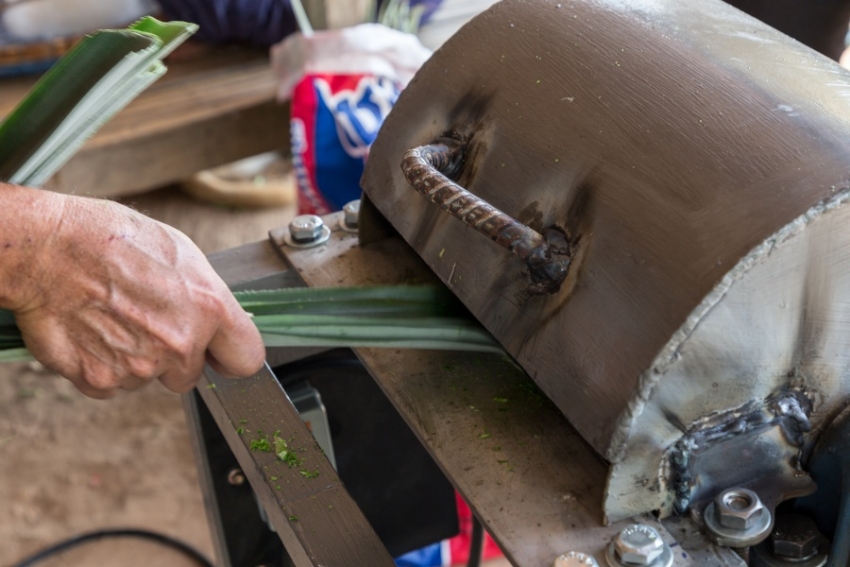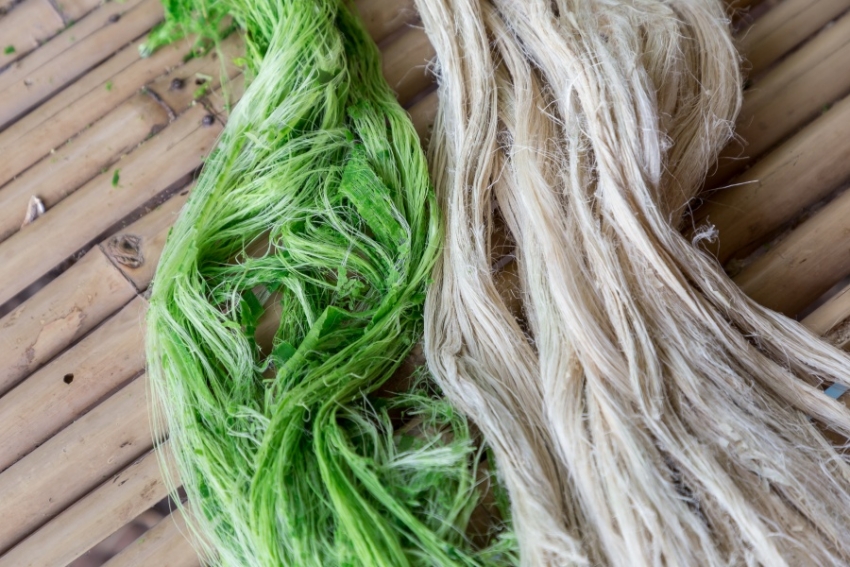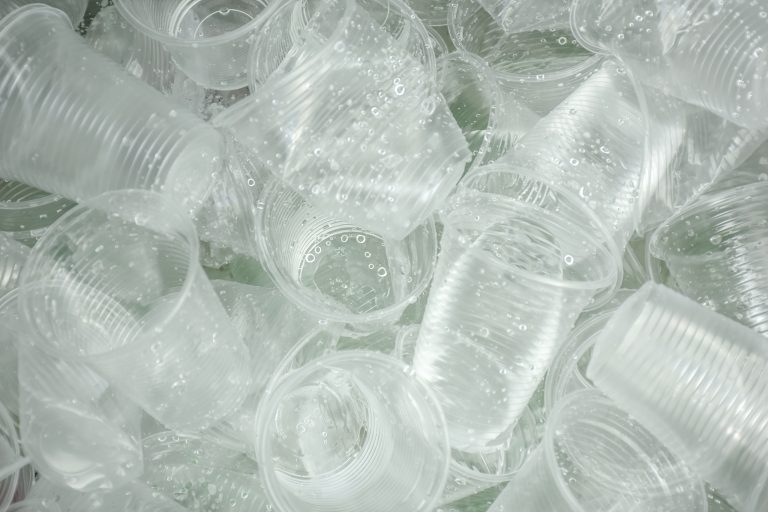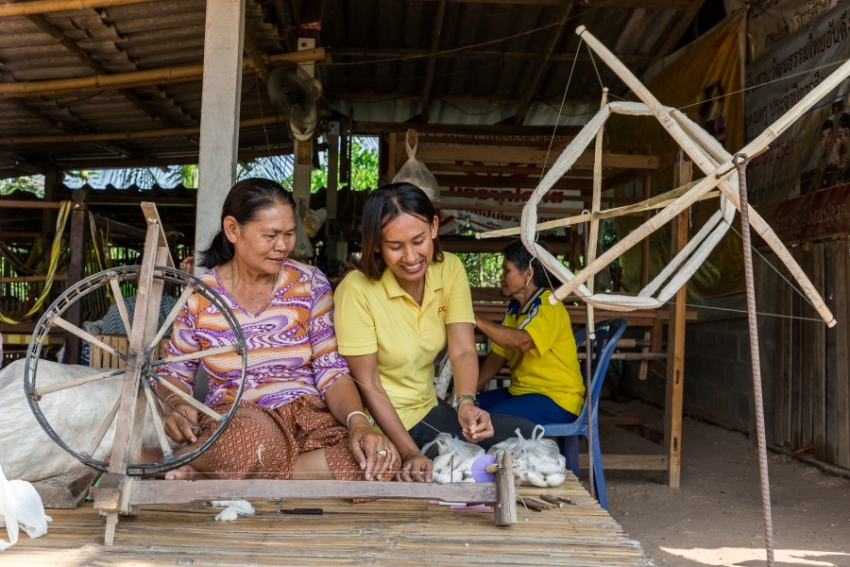The circular economy is a key approach that SCG has consistently integrated into various activities in a multi-faceted way. Circulating waste like pineapple leaves and plastic cups back into use through innovative means that add value to the materials, foster collaboration among community members, and contribute to the building of an open collaboration network is another example of success that brings pride to SCG.
Thinking Like a Local
Originally, the Khon Saen Witi Weaving Community Enterprise of Pluak Daeng District, Rayong Province specialized only in weaving monks’ robes with traditional looms. In 2015, Pattakarn Wattanasahoyothin, Director of the Office of the Non-Formal and Informal Education of Pluak Daeng District, initiated an industry shift towards making handwoven textiles dyed with mangosteen peel and tailored into ready-to-wear pieces. During the planning stage, a question arose of what household material could be incorporated into the fabric that would reflect the story of the community.
The Director and her team looked to the district’s motto “Sweet, Juicy Pineapples” for inspiration. Pineapples are abundant in the region, and when harvesting them, farmers pluck only the fruits, discarding the leaves. Pattakarn believed that the tensile strength of pineapple leaves should make them suitable for use in textile making. And thus the development of the innovative fiber from pineapple leaves began.
Through trial and error, research into the strengths and weaknesses of pineapple fiber samples from the Philippines, and, finally, process optimization to create the most suitable product for consumers, Pattakarn and her team succeeded in producing pineapple fabric in 2018 by blending pineapple fiber with cotton at a ratio of 40:60. The innovation of the Khon Saen Witi Weaving Community Enterprise perfectly combines the tensile strength of pineapple leaves with the softness of cotton.
"The benefit of fabric from pineapple fiber is its tensile strength, which makes it able to withstand laundry detergent and machine washing as well as extends the life of the fabric. Other features include the unique color of the pineapple fiber and its exfoliating properties. Thanks to local wisdom, the problem of scratchiness found in pineapple fiber from the Philippines was solved by simply pounding the fibers in a stone mortar to soften the rough edges. Additionally, pineapple fiber absorbs sweat well, making it comfortable to wear,” the Director explained.
Aside from the invention of a method to improve the quality of the fiber, the development of the manufacturing process also involved the design of a pineapple leaf processing machine. This new invention replaces the need for manual labor in scraping each leaf with a spoon, thus producing fibers at a faster rate, and reduces jerk-back, which is a common problem in commercially available fiber extraction machines. All of these developments resulted from the initiative and efforts of the community.
A Good Partner is Key
“We were introduced to SCG at a trade show, and we heard that the Company had conducted research on producing fibers from recycled plastic, so we decided to collaborate on an experiment to see how we could incorporate these plastic fibers into fabric,” Pattakarn recollected.
The fabric produced by the Khon Saen Witi Weaving Community Enterprise uses natural fiber for the warp (vertical) yarns and plastic fiber for the weft (horizontal) yarns. The team is still in the process of optimizing a fiber blend that is most suitable for the weaving process. Although plastic fiber is more challenging to weave because the strands don’t adhere to one another unlike cotton, coupled with its relative slipperiness, which can make the shape of the resulting fabric unstable, thus requiring more skill and expertise in the weaving process, this collaboration is the first step toward expanding the opportunity to create innovations that turn traditional wisdom into local products.
Besides working closely with the community and exchanging creative ideas in order to build knowledge and develop plastic fibers into aesthetically pleasing and functional fabric, SCG also supports the local industry with equipment and tools, such as providing flying shuttle looms, which allow for more efficient fabric production compared to traditional looms, as well as organizing activities to help elevate the status of the Community Enterprise, so that they are now featured in functions to represent the province and the country.
"Producing fabric from plastic fiber isn’t just about creating a product, but it’s also about shifting the mindset and feeling of community members about waste towards a more conscious approach to household waste management, such as increased mindfulness when using plastic and initiative in sorting waste like plastic coffee cups, because of a realization that if we sort and recycle trash properly, it can be turned into something useful and valuable,” Director Pattakarn concluded.
SCG continues our commitment to promoting the circular economy principles that are applicable in the lives of community members in order to support economic sustainability in the community along with the suitable and efficient management of local resources.








